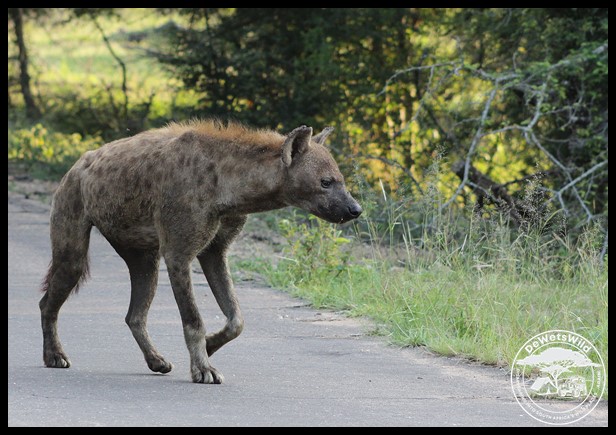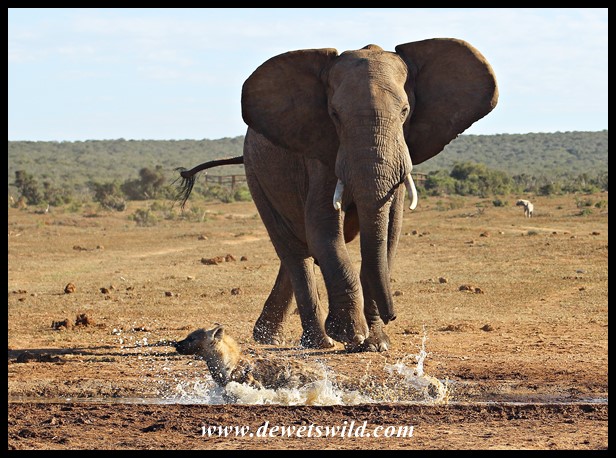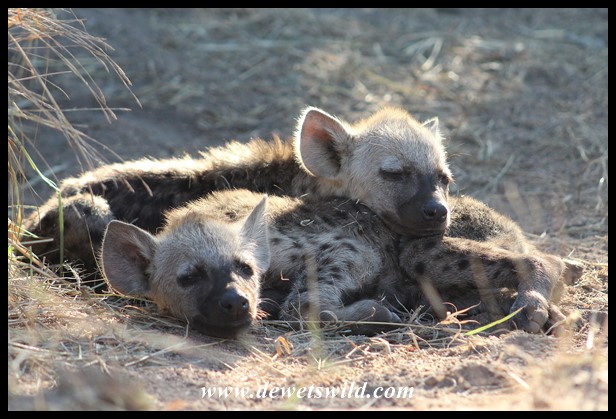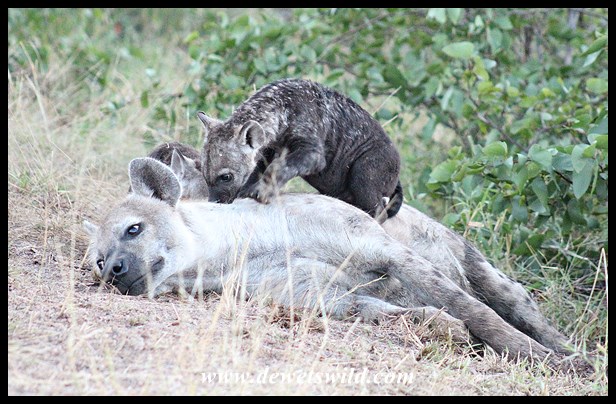Spotted Hyenas are probably the most numerous large predator in the Kruger National Park, with a population estimated at around 7,000. While many people still hold on to incorrect beliefs that the Spotted Hyena is a cowardly scavenger, amongst other insults, we know better and are always excited when we get a chance to spend time with these fascinating carnivores.

Spotted Hyenas

Spotted Hyena (photo by Joubert)

Spotted Hyena (photo by Joubert)

Spotted Hyena with a bitten ear

Spotted Hyena

Spotted Hyena (photo by Joubert)

Spotted Hyena

Spotted Hyena

Spotted Hyena
For the entire duration of our December 2021 visit to the Satara area of the Kruger National Park a large pack of Hyenas maintained a den site about 3km to the north of the camp, along the H1-4 road. We regularly encountered these Hyenas, of all sexes and ages, while setting out or returning to camp and seldom left them without more photographs to add to the album.

Spotted Hyena at a den just north of Satara (photo by Joubert)

Spotted Hyena at a den just north of Satara (photo by Joubert)

Spotted Hyena at a den just north of Satara

Spotted Hyena at a den just north of Satara

Spotted Hyena at a den just north of Satara

Spotted Hyenas at a den just north of Satara (photo by Joubert)

Spotted Hyena at a den just north of Satara

Spotted Hyena at a den just north of Satara (photo by Joubert)

Spotted Hyena at a den just north of Satara (photo by Joubert)

Spotted Hyena at a den just north of Satara (photo by Joubert)

Spotted Hyena (photo by Joubert)

Spotted Hyena

Spotted Hyena
This little family was a different story however. Along the Ngotso stream one very hot day early into our visit we came across a Spotted Hyena female with the two most lovable cubs imaginable. Though we looked for them in the same vicinity on several occasions later on we weren’t lucky to see them again.

Spotted Hyena mother and cub

Spotted Hyena cub

Spotted Hyena cub

Spotted Hyena cub

Spotted Hyena cub

Spotted Hyena cub (photo by Joubert)

Spotted Hyena cub (photo by Joubert)
Just south of Tshokwane, where the main road to Lower Sabie turns off, as we were heading home on the 2nd of January, we noticed a big female Hyena standing next to a culvert. In Kruger Spotted Hyenas make good use of these man-made tunnels as dens. Sure enough, as we brought our vehicle to a halt first one, then a second and then a third little head popped out from underneath the road to inspect the strange creature humming on top of their home.

Spotted Hyena cub

Spotted Hyena cubs

Spotted Hyena cubs

Spotted Hyena cub

Spotted Hyena female

Spotted Hyena cub (photo by Joubert)
So often when we encounter Spotted Hyenas they are on the move with a single-minded sense of purpose. This very big individual came running from the front at great speed along the road to Tshokwane one morning, only to disappear into the bush before we could even turn the car around.

Spotted Hyena going for a jog

Spotted Hyena out for its morning jog

Spotted Hyena out for its morning jog

Spotted Hyena out for its morning jog

Spotted Hyena out for its morning jog
While they’re not always doing it on the trot, it happens very often that we find a Hyena, like this one near Balule, striding along the road to pass us as if it didn’t even notice us.

Spotted Hyena walking along the road near Balule (photo by Joubert)

Spotted Hyena walking along the road near Balule

Spotted Hyena walking along the road near Balule (photo by Joubert)

Spotted Hyena walking along the road near Balule

Spotted Hyena walking along the road near Balule
Spotted Hyenas are great opportunists. We found this one hanging around a herd of impalas that included lots of newborn lambs along the S126 Sweni Road.

Spotted Hyena on the lookout for newborn Impalas

Spotted Hyena on the lookout for newborn Impalas

Spotted Hyena on the lookout for newborn Impalas
At the Vutomi Dam, west of Tshokwane, we saw two Spotted Hyenas enjoying a refreshing dip in a muddy pool on a hot day before they headed off into the veld.

Spotted Hyenas bathing at Vutomi

Spotted Hyenas bathing at Vutomi

Spotted Hyenas bathing at Vutomi

Spotted Hyenas bathing at Vutomi

Spotted Hyenas bathing at Vutomi (photo by Joubert)

Spotted Hyenas bathing at Vutomi

Spotted Hyenas bathing at Vutomi (photo by Joubert)

Spotted Hyenas bathing at Vutomi (photo by Joubert)

Spotted Hyena taking a quick drink from Vutomi Dam…

Spotted Hyena taking a quick drink from Vutomi Dam…

…before they headed back into the bush

…before they headed back into the bush
One morning, near the turnoff to Olifants Rest Camp, we found a very nervous Spotted Hyena with the tip of its nose hanging by a thread.
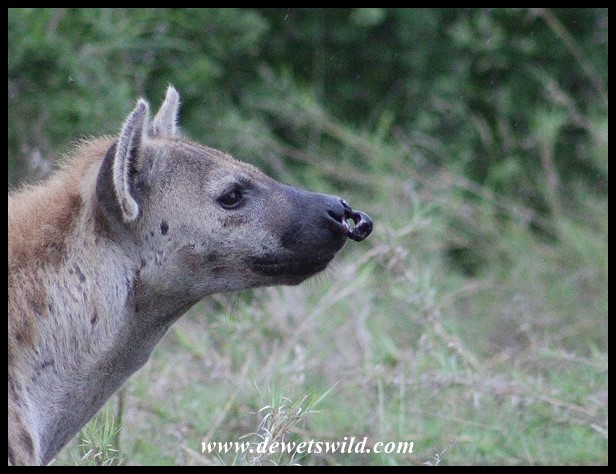
Soon after we found four more Hyenas, which were very excited, patrolling up and down the road as if they were looking for something. Perhaps they were looking for the Hyena with the hurt nose. They ran along the road and then stopped at some invisible scent marks, growling and grunting loudly and scent marking in the same spot before running off to the next one. This was fascinating behaviour we have never observed before, and whoever they were looking for would have done well to stay out of this posse’s way!

Spotted Hyena (photo by Joubert)

Excited Spotted Hyenas patrolling along the Olifants River

Excited Spotted Hyenas patrolling along the Olifants River (photo by Joubert)

Excited Spotted Hyenas patrolling along the Olifants River

Excited Spotted Hyenas patrolling along the Olifants River

Excited Spotted Hyenas patrolling along the Olifants River

Excited Spotted Hyenas patrolling along the Olifants River (photo by Joubert)

Excited Spotted Hyenas patrolling along the Olifants River (photo by Joubert)

Excited Spotted Hyenas patrolling along the Olifants River (photo by Joubert)

Excited Spotted Hyenas patrolling along the Olifants River (photo by Joubert)

Excited Spotted Hyenas patrolling along the Olifants River (photo by Joubert)

Excited Spotted Hyenas patrolling along the Olifants River

Excited Spotted Hyenas patrolling along the Olifants River

Excited Spotted Hyenas patrolling along the Olifants River
When we passed the same way several hours later the matriarch of the group was still patrolling up and down the same stretch of road. How is that for dogged perseverance!?



